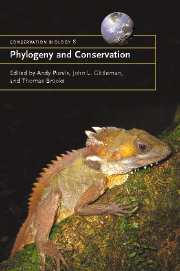Book contents
- Frontmatter
- Contents
- List of contributors
- 1 Phylogeny and conservation
- Part 1 Units and currencies
- 2 Molecular phylogenetics for conservation biology
- 3 Species: demarcation and diversity
- 4 Phylogenetic units and currencies above and below the species level
- 5 Integrating phylogenetic diversity in the selection of priority areas for conservation: does it make a difference?
- 6 Evolutionary heritage as a metric for conservation
- Part 2 Inferring evolutionary processes
- Part 3 Effects of human processes
- Part 4 Prognosis
- Index
- References
3 - Species: demarcation and diversity
Published online by Cambridge University Press: 04 December 2009
- Frontmatter
- Contents
- List of contributors
- 1 Phylogeny and conservation
- Part 1 Units and currencies
- 2 Molecular phylogenetics for conservation biology
- 3 Species: demarcation and diversity
- 4 Phylogenetic units and currencies above and below the species level
- 5 Integrating phylogenetic diversity in the selection of priority areas for conservation: does it make a difference?
- 6 Evolutionary heritage as a metric for conservation
- Part 2 Inferring evolutionary processes
- Part 3 Effects of human processes
- Part 4 Prognosis
- Index
- References
Summary
Arguments about conservation are almost always arguments about species. Lists are compiled of endangered species, conservation schemes are prioritised on how many species are preserved, and legislation is phrased in terms of species. In the political economy of biodiversity, species are the currency. Despite this central role, the very term ‘species’ is deeply ambiguous. Practitioners clash not only over the boundaries of individual species, but also over what ‘species’ means. Where once ‘the species problem’ referred to the puzzle of how species arose, it now refers to how species can be defined (Mallet 2001).
This argument has deep implications for conservation biology. As species definitions (and thus boundaries) shift, species counts may rise and fall. Areas of endemism based on species counts could change, and the conservation worth of populations with an ambiguous status (such as hybrids and sub-species) will fluctuate based on their taxonomic rank (Collar 1997). Given such doubt, how precise are our current understandings of species numbers and identity? Are these estimates good enough for conservation practice?
A DIVERSITY OF CONCEPTS
The argument over how species should be defined is endless, with over 20 species concepts presently in circulation (Claridge et al. 1997; Mayden 1997; Howard & Berlocher 1998). The problematic issue (at least for biodiversity studies) has been the gap between theory and practice. Although many concepts have been based on seemingly sound ideals, these tend to founder in the real world.
- Type
- Chapter
- Information
- Phylogeny and Conservation , pp. 57 - 75Publisher: Cambridge University PressPrint publication year: 2005
References
- 12
- Cited by



